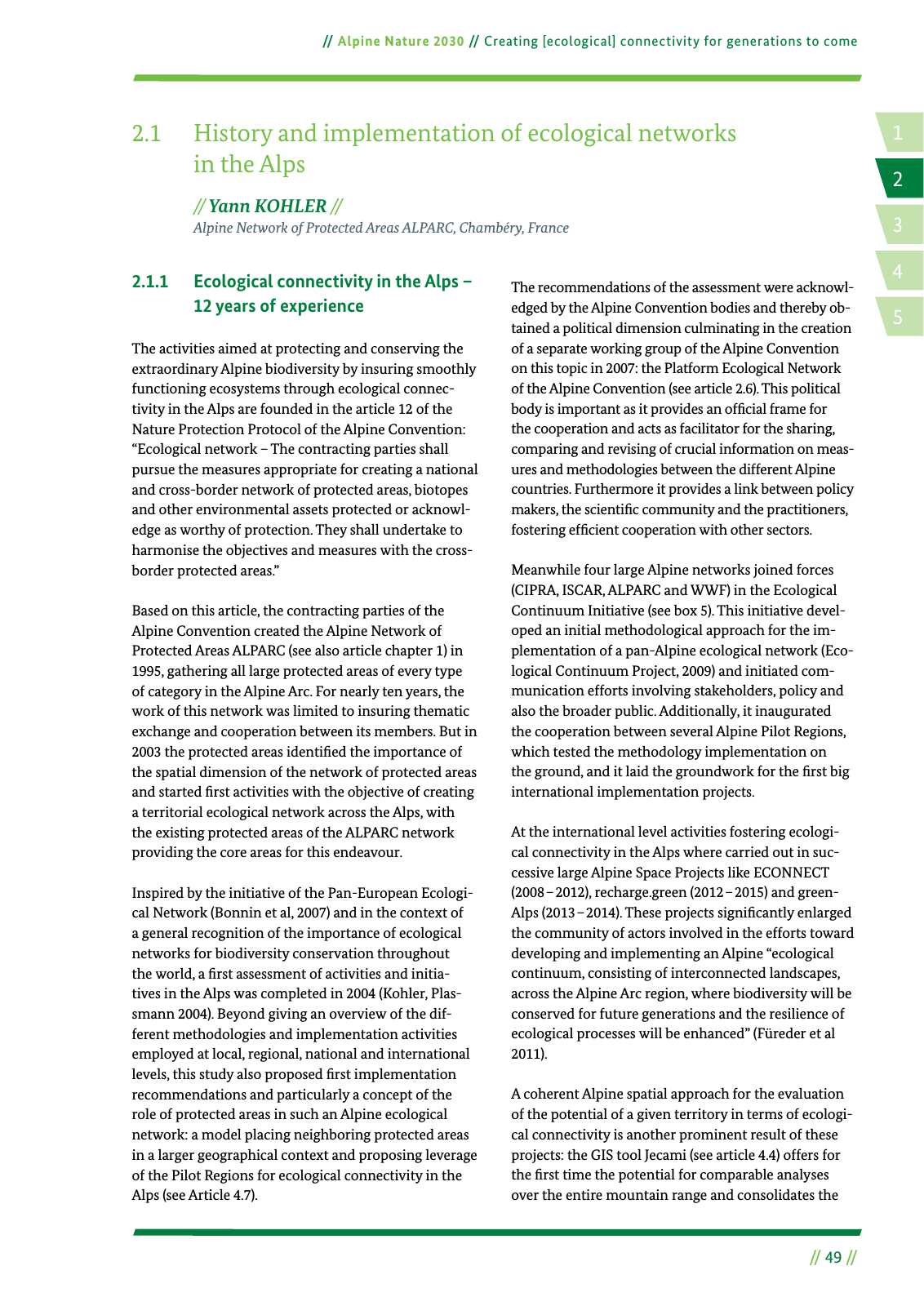14 2 5 3 49 Alpine Nature 2030 Creating ecological connectivity for generations to come 2 1 History and implementation of ecological networks in the Alps Yann KOHLER Alpine Network of Protected Areas ALPARC Chambéry France 2 1 1 Ecological connectivity in the Alps 12 years of experience The activities aimed at protecting and conserving the extraordinary Alpine biodiversity by insuring smoothly functioning ecosystems through ecological connec tivity in the Alps are founded in the article 12 of the Nature Protection Protocol of the Alpine Convention Ecological network The contracting parties shall pursue the measures appropriate for creating a national and cross border network of protected areas biotopes and other environmental assets protected or acknowl edge as worthy of protection They shall undertake to harmonise the objectives and measures with the cross border protected areas Based on this article the contracting parties of the Alpine Convention created the Alpine Network of Protected Areas ALPARC see also article chapter 1 in 1995 gathering all large protected areas of every type of category in the Alpine Arc For nearly ten years the work of this network was limited to insuring thematic exchange and cooperation between its members But in 2003 the protected areas identi ed the importance of the spatial dimension of the network of protected areas and started rst activities with the objective of creating a territorial ecological network across the Alps with the existing protected areas of the ALPARC network providing the core areas for this endeavour Inspired by the initiative of the Pan European Ecologi cal Network Bonnin et al 2007 and in the context of a general recognition of the importance of ecological networks for biodiversity conservation throughout the world a rst assessment of activities and initia tives in the Alps was completed in 2004 Kohler Plas smann 2004 Beyond giving an overview of the dif ferent methodologies and implementation activities employed at local regional national and international levels this study also proposed rst implementation recommendations and particularly a concept of the role of protected areas in such an Alpine ecological network a model placing neighboring protected areas in a larger geographical context and proposing leverage of the Pilot Regions for ecological connectivity in the Alps see Article 4 7 The recommendations of the assessment were acknowl edged by the Alpine Convention bodies and thereby ob tained a political dimension culminating in the creation of a separate working group of the Alpine Convention on this topic in 2007 the Platform Ecological Network of the Alpine Convention see article 2 6 This political body is important as it provides an of cial frame for the cooperation and acts as facilitator for the sharing comparing and revising of crucial information on meas ures and methodologies between the different Alpine countries Furthermore it provides a link between policy makers the scienti c community and the practitioners fostering ef cient cooperation with other sectors Meanwhile four large Alpine networks joined forces CIPRA ISCAR ALPARC and WWF in the Ecological Continuum Initiative see box 5 This initiative devel oped an initial methodological approach for the im plementation of a pan Alpine ecological network Eco logical Continuum Project 2009 and initiated com munication efforts involving stakeholders policy and also the broader public Additionally it inaugurated the cooperation between several Alpine Pilot Regions which tested the methodology implementation on the ground and it laid the groundwork for the rst big international implementation projects At the international level activities fostering ecologi cal connectivity in the Alps where carried out in suc cessive large Alpine Space Projects like ECONNECT 2008 2012 recharge green 2012 2015 and green Alps 2013 2014 These projects signi cantly enlarged the community of actors involved in the efforts toward developing and implementing an Alpine ecological continuum consisting of interconnected landscapes across the Alpine Arc region where biodiversity will be conserved for future generations and the resilience of ecological processes will be enhanced Füreder et al 2011 A coherent Alpine spatial approach for the evaluation of the potential of a given territory in terms of ecologi cal connectivity is another prominent result of these projects the GIS tool Jecami see article 4 4 offers for the rst time the potential for comparable analyses over the entire mountain range and consolidates the

Hinweis: Dies ist eine maschinenlesbare No-Flash Ansicht.
Klicken Sie hier um zur Online-Version zu gelangen.
Klicken Sie hier um zur Online-Version zu gelangen.